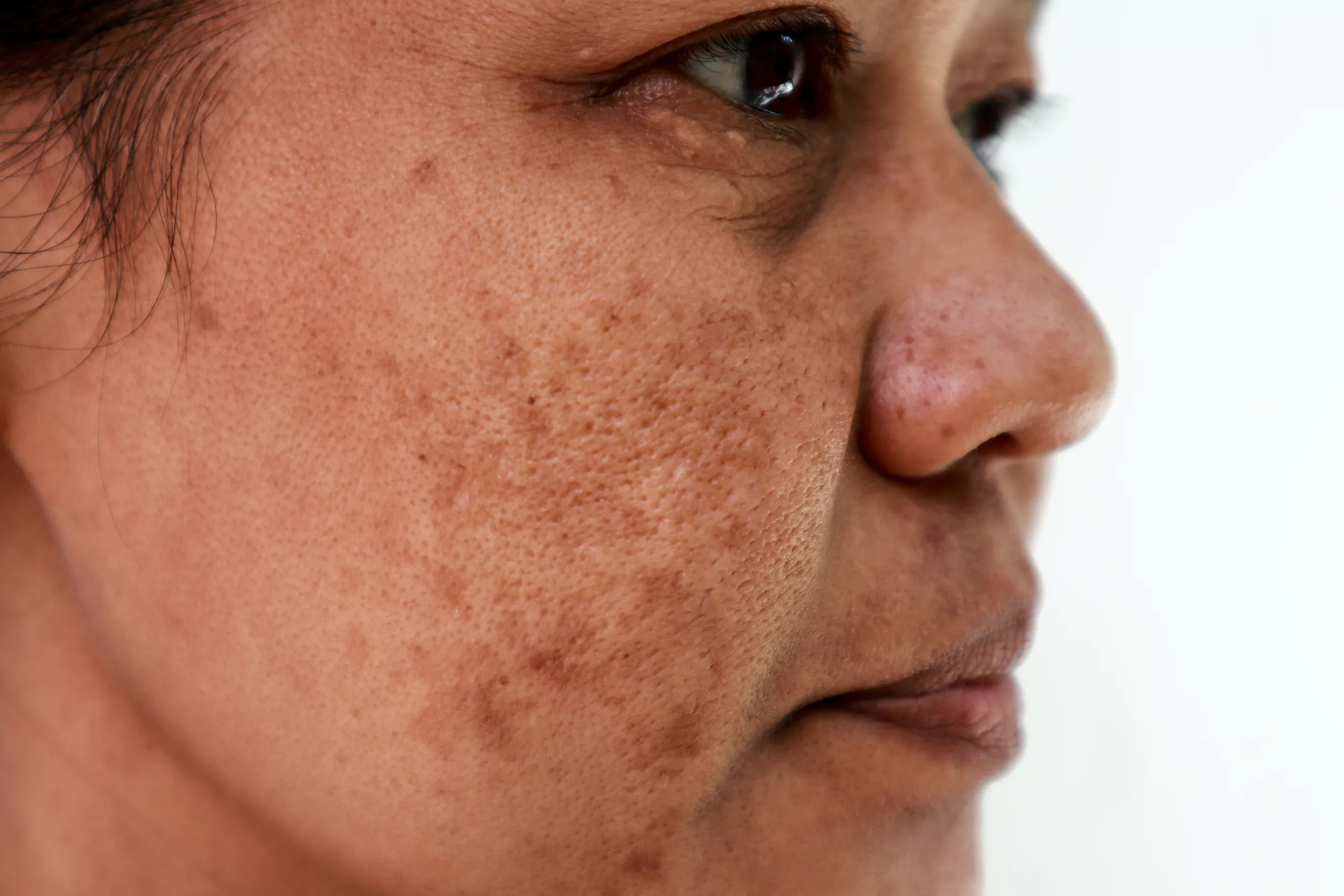
Melasma, a common skin condition characterized by hyperpigmentation, often appears as dark patches on the face, causing distress for affected men and women. While not harmful, this condition can significantly impact one’s self-esteem and confidence. Discover the leading melasma causes and treatments in Las Vegas. Get expert advice on finding the best melasma treatment in Las Vegas.
Below, we delve into the intricacies of this skin disorder, exploring its causes, symptoms, and various treatment options in Las Vegas.
What Is Melasma?
Melasma is a skin problem involving the development of brown or gray-brown patches, primarily on the face. These patches typically appear on the forehead, nose, upper lip, cheeks, chin, and forearms — areas more prone to sun exposure. While this skin disorder can affect anyone, women are more at risk than men, especially during pregnancy (known as chloasma or the “mask of pregnancy”).
The disorder affects a wide range of the general population, from 1.5% to 33%, with its onset primarily during a woman’s child-bearing years, seldom occurring during adolescence, and usually manifesting between the ages of 20 and 40. Experts categorize melasma into three distinct types:
- Epidermal Type . Characterized by its dark brown hue, clear borders, and capacity to respond favorably to treatment.
- Dermal Type. Presents a light brown or bluish color with indistinct borders and, unfortunately, tends to resist treatment.
- Mixed Type. Exhibits both bluish and brown patches and typically shows a partial response to treatment.
The skin, the largest organ in your body, has three layers: the epidermis (outermost layer), dermis (middle layer), and subcutis (bottom layer). Within the epidermis reside melanocytes, responsible for storing and producing a dark pigment called melanin. Triggered by light, heat, ultraviolet radiation, or hormonal stimulation, melanocytes increase melanin production, darkening skin.
The diagnosis of melasma typically involves a careful visual inspection of the affected region. To exclude specific underlying causes, healthcare professionals may conduct additional tests. Among these tests, a Wood’s lamp examination is common. During this procedure, a unique light illuminates your skin, enabling the detection of any bacterial or fungal infections and helping ascertain the depth of melasma’s impact on your skin layers.
What Are the Causes of Melasma?
Understanding the causes of this skin disorder is crucial for both prevention and effective treatment. While experts are yet to determine the exact cause, several factors contribute to the development of melasma:
- Hormonal Changes: As mentioned earlier, hormonal fluctuations, especially during pregnancy or with the use of hormonal contraceptives, can trigger.
- Sun Exposure: Excessive exposure to ultraviolet (UV) rays is a significant factor in the development of this skin disorder. UV rays stimulate the production of melanocytes, the cells responsible for skin pigmentation, leading to the formation of dark patches.
- Genetics and Ethnicity: This skin disorder is more common in individuals with darker skin tones, suggesting a genetic predisposition to increased pigmentation.
- Cosmetic and Skin Care Products: Certain cosmetics and skin care products can irritate the skin and trigger.
- Phototoxic Drugs: Phototoxic drugs are medications that react adversely to sunlight, leading to skin damage.
Signs and Symptoms of Melasma
Identifying the signs and symptoms of this skin disorder is essential for early intervention and effective management. This skin disorder manifests in shades of brown or bluish patches and, in some instances, freckle-like flat spots on your skin. Occasionally, these patches may turn red or become inflamed.
The condition typically appears in any of six distinct or combined areas of the skin, including the following:
- Brachial region (shoulders and upper arms)
- Centrofacial region (forehead, cheeks, nose, and upper lip)
- Lateral cheek pattern (both cheeks)
- Malar region (cheeks and nose)
- Mandibular region (along the jawline)
- Neck area (common in individuals aged 50 or above)
Melasma Causes and Treatments
How To Treat
In many cases, melasma dissipates naturally, often as a result of hormonal shifts returning to equilibrium, such as post-pregnancy or discontinuation of contraceptive pills. However, for some, this skin disorder is a persistent condition, lasting for numerous years or potentially for life.
In instances where this skin disorder does not naturally disappear, individuals can explore treatments to eradicate or at least diminish the noticeable patches.
Microneedling
Microneedling is a minimally invasive procedure using tiny needles to create micro-injuries on the skin’s surface. This procedure stimulates collagen production and helps improve skin texture and tone. In the context of melasma, microneedling can be beneficial in promoting the absorption of topical medications that target pigmentation.
IPL (Intense Pulsed Light) Therapy
IPL therapy uses broad-spectrum light to target pigmented cells. This therapy is particularly effective in treating melasma caused by sun exposure. The melanin absorbs the light energy, breaks it down, and reduces the appearance of dark patches. IPL is a non-invasive procedure with minimal downtime, making it a popular choice for this treatment.
Chemical Peel
A chemical peel is a procedure that applies a chemical solution to exfoliate the outer layer of skin. This process helps reduce hyperpigmentation and improve overall skin texture. Superficial peels are commonly used for melasma, targeting the epidermis without causing significant downtime.
Topical Medications
Dermatologists can prescribe various topical medications to manage this skin disorder, including hydroquinone, tretinoin, corticosteroids, or a combination of these ingredients. These medications work by inhibiting melanin production and promoting skin cell turnover.
To prevent the worsening of melasma and minimize its visibility, you can use cosmetic concealment of discolored patches using makeup, adhere to prescribed medication regimens, and use an SPF 30 sunscreen daily. Donning protective clothing during prolonged exposure to the sun can also be particularly beneficial.
If you feel self-conscious about your melasma, contact your healthcare provider for information on local support groups or therapy services. Engaging with others dealing with melasma or discussing your feelings with a counselor may provide significant emotional relief.
Visit RareV Medspa for Melasma Treatment in Las Vegas
Melasma is a challenging condition that you can manage with the right approach. If you’re seeking professional and effective melasma treatment in Las Vegas, look no further than RareV Medspa. Our experienced team of skin experts provides personalized solutions to address your specific needs, offering a range of cutting-edge treatments.
At RareV Medspa, we prioritize your well-being and satisfaction. Our state-of-the-art facilities and advanced technologies ensure you receive the highest standard of care. Schedule a consultation now and let us create a customized treatment plan to restore your skin’s natural beauty.

